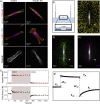Vinculin and the mechanical response of adherent fibroblasts to matrix deformation
- PMID: 30568231
- PMCID: PMC6299284
- DOI: 10.1038/s41598-018-36272-9
Vinculin and the mechanical response of adherent fibroblasts to matrix deformation
Abstract
Cells respond to the mechanics of their environment. Mechanical cues include extracellular matrix (ECM) stiffness and deformation, which are primarily sensed through integrin-mediated adhesions. We investigated the impact of ECM deformation on cellular forces, measuring the time-evolution of traction forces of isolated mouse fibroblasts in response to stretch and release. Stretch triggered a marked increase of traction stresses and apparent stiffness. Expression of the focal adhesion protein vinculin not only increased baseline traction forces, but also increased dissipation of mechanical energy, which was correlated with the cells' failure to recover baseline traction forces after release of stretch.
Conflict of interest statement
The authors declare no competing interests.
Figures




References
Publication types
MeSH terms
Substances
Grants and funding
LinkOut - more resources
Full Text Sources

